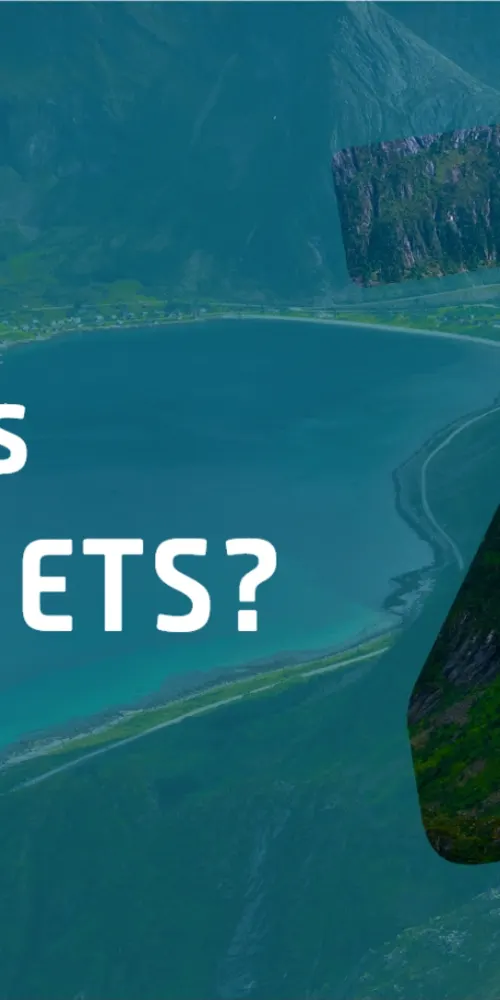What is the EU ETS?
Four steps to understand Europe's Emissions Trading System

The EU Emissions Trading System (EU ETS) is a cornerstone of the European Union's efforts to combat climate change and reduce greenhouse gas emissions. As one of the world's largest carbon markets, the EU ETS operates on a cap-and-trade principle, aiming to incentivise emissions reduction across various industries.
Today, the European Commission is considering a revised version of the EU ETS directive which would go into effect in 2024, further impacting all vessels operating to or from ports in the EU or EEA.
What is the EU ETS?
The EU ETS is a market-based mechanism designed to reduce greenhouse gas emissions in the EU. The shipping industry has been included in the ETS since January 1, 2022, which means that ship operators must purchase carbon credits to cover their emissions above a certain threshold.
Key Features of the EU ETS
Cap-and-trade mechanism: The EU ETS places a cap, or limit, on the total amount of greenhouse gas emissions that participating industries can release. The cap is reduced over time, leading to emission reductions. Within this capped limit, companies receive or purchase allowances, which represent the right to emit a certain amount of greenhouse gases.
Compliance and reporting: Companies covered by the EU ETS are required to monitor and report their actual emissions, ensuring transparency and accountability. Compliance entails surrendering enough allowances to cover their verified emissions at the end of each compliance period.
Trading and flexibility: The EU ETS allows participants to trade allowances, providing flexibility in meeting their emission reduction obligations. Market participants can buy additional allowances if they exceed their allocated amount or sell surplus allowances if they have successfully reduced their emissions.
How does this affect the shipping industry?
Starting from January 1, 2022, the EU ETS expanded to include the shipping industry, marking a significant step toward addressing the sector's emissions, which were previously exempt from carbon pricing mechanisms.
Now it is agreed that ship operators must purchase carbon credits to cover emissions above a certain threshold, creating a financial incentive to reduce emissions and improve efficiency.
If the agreement is formally adopted, starting in 2024, the EU ETS will incorporate emissions from maritime transport. Shipping companies will be responsible for paying for the emissions they reported in the previous year in a phased implementation approach:
- In 2025, companies will pay for 40% of the emissions they reported in 2024
- In 2026, they will pay for 70% of their emissions from 2025
- From 2027 onwards, they will cover 100% of their reported emissions
This phased approach aims to send a price signal aligned with the polluter-pays principle, incentivising the decarbonisation of the maritime sector.
How can vessel owners and operators best respond to the EU ETS?
Like any change in the market, the EU ETS presents both challenges and opportunities for the shipping industry. By putting a price on carbon, the system incentivises emissions reductions and encourages companies to invest in cleaner technologies and practices, improve vessel design, optimise operational efficiencies, and explore alternative fuel, ultimately fostering innovation and supporting the EU's climate goals in decarbonisation.
Compliance with the EU ETS will also, by design, increase costs for companies who exceed their emissions threshold, presenting a significant risk to organisations that are unable to meet the requirements. On the other hand, it also provides an opportunity for operators to sell excess allowances on the market, rewarding emission reduction efforts and promoting innovation.
What steps can owners and operators take to reduce emissions and comply with the EU ETS?
Finding the right technology partner is essential, as both compliance and optimisation depend on the efficient collection and reporting of required data.
ZeroNorth can help shipping businesses meet the requirements set out by the EU ETS by providing data-driven insights and analytics to optimise vessel performance and reduce emissions. Our software platform uses artificial intelligence and machine learning to identify opportunities for efficiency improvements and provide real-time performance monitoring and easy reporting.
Learn more about how our platform supports the shipping industry to streamline compliance, reduce CO2 emissions, and increase earnings.